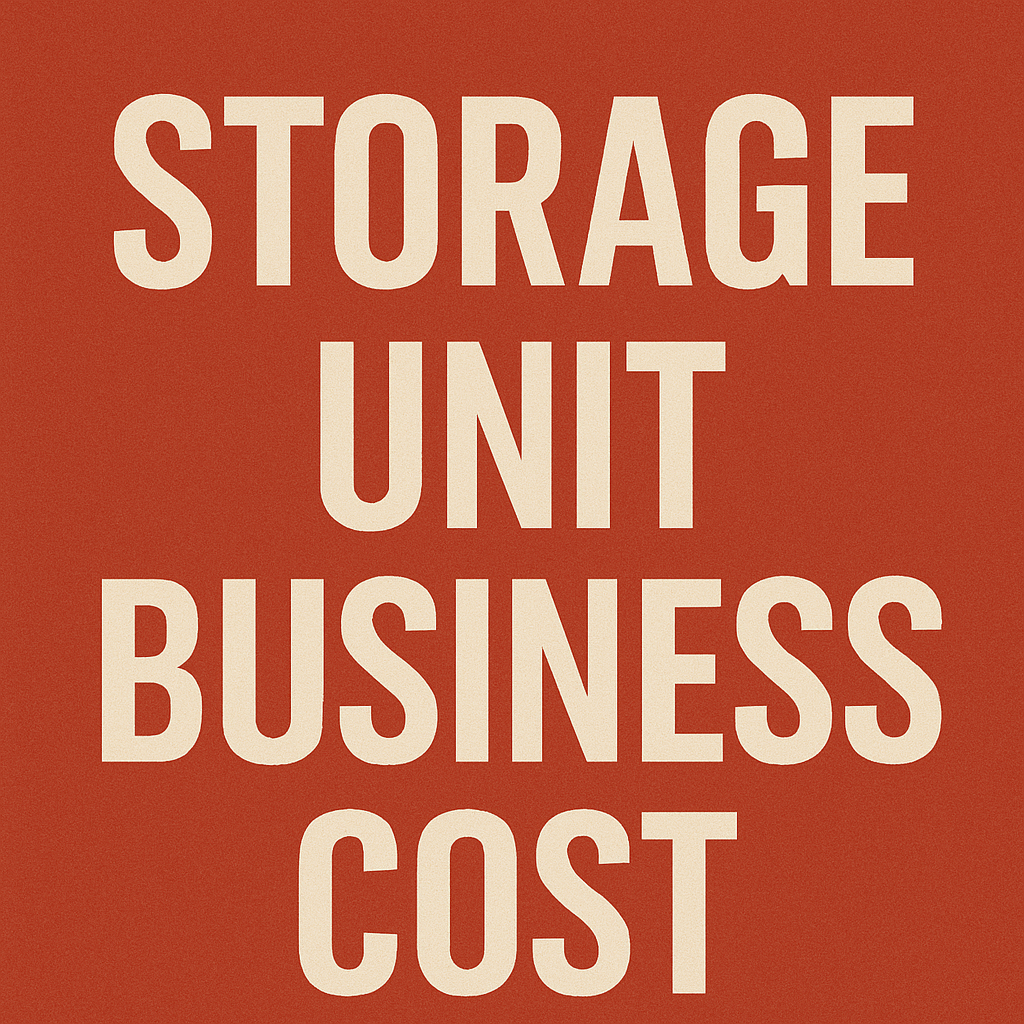Entering the self-storage industry offers a unique blend of challenges and rewards. With top-performing facilities generating millions annually, this sector combines real estate potential with steady demand. However, launching a successful storage business requires careful financial planning and a clear grasp of upfront commitments.
Initial investments typically range from $1.25 million to $2.5 million for new construction. These figures cover land purchases, building materials, permits, and operational setup. Savvy entrepreneurs often explore acquiring existing locations, which can significantly reduce startup expenses while providing immediate cash flow.
Location plays a pivotal role in determining your total investment. Urban markets might offer higher rental rates but come with steeper land costs. Rural areas could provide affordable entry points but may require creative marketing strategies. Facility size and amenities also dramatically impact budgets – climate-controlled units or advanced security systems add value but increase initial outlays.
The industry’s recession-resistant nature makes it appealing for long-term wealth building. With 10.6% annual growth projected through 2030, now marks an ideal time to explore this opportunity. This guide breaks down every expense category, from insurance premiums to staffing needs, helping you create a realistic financial roadmap.
Key Takeaways
- New facility construction costs typically range from $1.25M to $2.5M
- Existing property purchases offer lower upfront investment requirements
- Location significantly impacts land acquisition and operational costs
- Specialized features increase value but require higher initial spending
- Industry growth trends suggest strong long-term profitability potential
Understanding the Self Storage Business Model
When expanding your business portfolio, researching storage unit building cost becomes essential for making informed investment decisions. The construction expenses vary significantly based on location, size, materials, and local regulations, making it crucial to obtain multiple quotes and factor in all associated costs from land preparation to security systems installation.
At its core, the storage business solves space challenges through adaptable solutions. By renting secure units to diverse clients, operators create recurring income while addressing practical needs. This model thrives on simplicity – no complex inventory or perishable goods to manage.
Revenue Streams and Market Demand
Monthly rentals form the backbone of earnings. Prices vary by unit size and features, with climate-controlled spaces often commanding premium rates. Urban locations near colleges or business districts typically see higher demand, allowing for competitive pricing strategies.
The industry’s stability stems from constant life transitions. Consider these common scenarios:
- Students storing dorm items during summer breaks
- Families downsizing homes but keeping heirlooms
- E-commerce sellers needing inventory space
Customer Needs and Service Flexibility
Successful operators prioritize convenience. Most customers value 24/7 access and month-to-month agreements over long leases. Offering multiple payment options and online account management boosts satisfaction.
Tailoring services to local needs creates competitive edges. In humid regions, dehumidified units attract clients storing sensitive items. Business users often appreciate package acceptance services or bulk discount plans.
Key Factors Influencing Start-Up Costs
Multiple variables shape the initial investment needed for a storage facility. Three primary elements dominate budget planning: property selection, building requirements, and specialized features. Smart operators balance these components to maximize value while maintaining profitability.
Land Acquisition and Site Development
Location dramatically affects land prices. Urban plots often exceed $25 per square foot, while rural areas might cost half that. Site preparation adds $4.25-$8 per square foot for essential groundwork.
Clearing trees, installing utilities, and creating drainage systems eat into budgets. Zoning laws in some regions require costly aesthetic upgrades like landscaping or facade treatments. Always verify local regulations before purchasing land.
Construction, Materials, and Climate Control Options
Building expenses swing between $25-$110 per square foot. Single-story designs save on structural costs, while multi-level facilities boost revenue potential. Steel remains the most impactful material expense, fluctuating with market prices.
Climate-controlled units demand 20-35% higher initial spending. However, they attract tenants needing premium protection for electronics, artwork, or furniture. These specialized spaces often justify their construction costs through 15-30% rental rate increases.
How Much Does It Cost to Start a Storage Unit Business
Launching a storage facility requires precise budgeting across multiple expense categories. A 100-unit project typically spans $756,500 to $1.25 million, with location and design choices creating significant price variations. Let’s examine where every dollar goes.
Core Expenditure Components
Land purchases consume 15-30% of budgets. Urban plots near highways might hit $350,000, while rural areas often stay below $200,000. Remember – zoning laws can add unexpected costs for landscaping or parking requirements.
Construction dominates budgets at $500,000-$650,000. Single-story designs average $35 per square foot, while multi-level facilities jump to $60+. One operator notes: “Steel prices can swing material costs by 18% monthly – lock contracts early.”
- Site preparation: $60k-$112k (grading, utilities)
- Materials: $85k-$140k (steel framing, doors)
- Security systems: $15k median
Don’t overlook ongoing expenses like insurance ($2,500/month) or management software. Climate-controlled units add 25% upfront but boost rental income. Always reserve 6-8 months’ operating capital – occupancy rarely hits 90% immediately.
Financing Options for Your Self Storage Venture
Securing the right funding mix can make or break your storage venture. Smart financing decisions balance risk and growth potential while keeping your project on budget. Lenders and investors prioritize strong business plans showing market demand and management expertise.
Real estate investors often research the cost to build self storage facility to understand the capital requirements for entering this profitable market. Understanding storage unit business prices helps investors evaluate revenue potential and return on investment calculations.
Construction planning involves determining the cost of building self storage units and understanding how much does it cost to build a storage facility with proper specifications. Detailed budgeting includes how much does it cost to build self storage units and cost to build a self storage facility for comprehensive project planning.
Specific construction costs include cost to build mini storage facilities and cost to build self storage for different facility sizes. Understanding cost to build storage unit facility and cost to build storage units helps investors plan their development budgets accurately.
Investment analysis involves how much does it cost to build a self storage facility and how much does it cost to build a self-storage facility for different market conditions. Business planning includes how much does it cost to build a storage unit business and how much does it cost to build storage units for operational planning.
Acquisition considerations include how much does it cost to buy a storage facility versus new construction options. Startup planning involves how much does it cost to start a self-storage business and starting a storage unit business with proper market analysis and financial planning.
These investments require significant capital but often provide steady cash flow and appreciation potential in growing markets with strong demand for storage solutions.
Bank Loans, SBA, and Bridge Financing
Traditional bank loans remain popular for storage facility development. Commercial real estate loans often cover 70-80% of property costs, requiring 20-30% down payments. The SBA 7(a) program helps newer entrepreneurs with longer repayment terms and lower collateral demands.
Bridge loans fill temporary gaps during construction phases. One lender notes:
“These short-term solutions work best when permanent financing is already secured for later stages.”
Private Investors and Self-Funding Strategies
Equity partnerships attract investors seeking passive income from the storage business. These deals typically exchange capital for 15-40% ownership stakes. Self-funding through retirement accounts or asset liquidation maintains full control but increases personal risk.
| Financing Type | Best For | Avg. Terms | Key Benefit |
|---|---|---|---|
| Bank Loans | Established businesses | 15-25 years | Low interest rates |
| SBA 7(a) | Newer operators | 10-25 years | 10% down payment |
| Private Equity | Rapid expansion | 5-7 year exit | No monthly payments |
Combining funding sources often yields optimal results. Many successful operators use personal savings for initial development costs while securing institutional loans for building expenses. Always compare multiple offers to align terms with your cash flow projections.
Navigating Licenses, Permits, and Insurance Requirements
Launching your venture demands careful attention to legal protections. Proper documentation shields your storage facility from risks while building trust with clients. Let’s explore the essential paperwork every operator needs.
-
Understanding the nuances of medical director requirements is key—discover more in our article on what RNs need to start their own IV hydration practice.
Essential Permits and Zoning Considerations
Local regulations shape your site preparation. Most areas require a general business license plus construction permits for new facilities. Zoning approvals often prove trickiest – storage operations typically need commercial or industrial designations.
Urban locations might require:
- Fire department permits for sprinkler systems
- Environmental assessments for flood-prone areas
- Signage approvals matching municipal codes
One zoning official notes:
“Applicants should budget 6-8 weeks for review processes. Delays often come from incomplete drainage plans.”
Insurance Coverage to Safeguard Your Investment
Comprehensive policies protect your property and revenue streams. Standard coverage includes building protection against natural disasters and liability for customer injuries. Specialty options prove equally vital.
Consider these protections:
- Customer goods liability for damaged stored items
- Business interruption coverage during repairs
- Workers’ compensation for employee accidents
Premiums vary significantly based on facilities size and location. Coastal regions often pay 22% more for storm coverage. Regular policy reviews ensure adequate protection as your operation grows.
Marketing Strategies to Promote Your Business
Effective promotion separates thriving storage facilities from underperforming ones. A multi-channel approach combines digital tools with community engagement to attract diverse customers.
Digital Marketing and SEO Tactics
A professional website acts as your digital storefront. Features like real-time unit availability and virtual tours convert 43% more visitors than basic sites. Optimize for local searches by targeting phrases like “climate-controlled storage Austin” in page titles and blog content.
Google My Business profiles drive 64% of local discovery. Regularly update photos and respond to reviews. Social platforms let you showcase security features through video walkthroughs. One operator shares:
“Our Instagram reels showing package handling procedures tripled inquiry calls.”
Local Advertising and Partnership Opportunities
Billboards near apartment complexes and universities capture relocating residents. Sponsor little league teams or charity events for brand visibility. These efforts build trust within your service area.
Cross-promotions with moving companies create win-win relationships. Offer discounted truck rentals to tenants who sign six-month leases. Real estate agents often refer clients needing temporary storage during home transitions.
Email campaigns keep your business top-of-mind. Share organizing tips alongside promotional offers. Track open rates to refine messaging for different customer groups.
Operational Excellence and Management Tips
Streamlining operations separates top-performing storage facilities from average ones. Smart operators combine technology with hands-on oversight to maximize efficiency while maintaining tenant satisfaction. This balance drives long-term success in competitive markets.
Powering Operations With Smart Technology
Modern management software transforms daily tasks. Automated rent collection and payment reminders reduce administrative headaches. Real-time occupancy dashboards help adjust pricing dynamically – a game-changer during seasonal demand shifts.
These systems also handle customer communications and maintenance requests. Mobile apps allow tenants to manage units remotely, boosting convenience. One operator notes: “Our management platform cut late payments by 37% through SMS alerts.”
Building Trust Through Facility Care
Robust security systems form the backbone of customer confidence. Motion-activated cameras and biometric access controls prevent unauthorized entry. Regular inspections keep lighting and climate systems functioning optimally.
Daily maintenance preserves your property’s value. Quick fixes to damaged doors or parking areas prevent bigger issues. Staff trained in conflict resolution turn frustrated customers into loyal advocates through empathetic service.
Adding value drives revenue beyond rentals. Selling packing supplies or partnering with moving companies creates convenient solutions. These extras account for 12-18% of profits at thriving facilities while enhancing tenant experiences.







